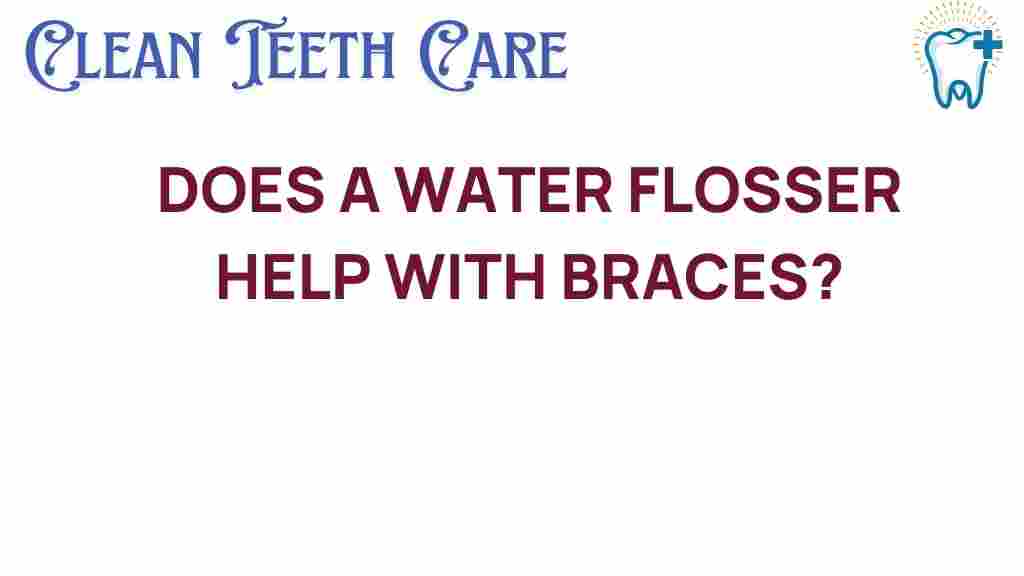Unlocking the Truth: Do Water Flossers Really Benefit Braces?
Maintaining optimal oral hygiene is crucial for everyone, especially for those undergoing orthodontic treatment with braces. One of the most debated tools in modern dental care is the water flosser. Many patients and orthodontists wonder whether a water flosser is a worthy investment for maintaining gum health and ensuring effective plaque removal. In this article, we will explore the benefits and considerations of using a water flosser for braces, providing insights into how it can enhance your smile maintenance.
The Importance of Oral Hygiene with Braces
Braces create unique challenges for oral hygiene. Traditional flossing can be cumbersome with brackets and wires, making it easy for food particles and plaque to accumulate. This accumulation can lead to:
- Increased risk of cavities
- Gum disease
- Staining of teeth
For these reasons, it is essential to adopt effective methods for cleaning around the brackets and wires. This is where a water flosser can come into play.
How Does a Water Flosser Work?
A water flosser, also known as an oral irrigator, utilizes a stream of pulsating water to remove food debris and plaque from between teeth and along the gum line. Unlike traditional floss, which can be difficult to maneuver around braces, a water flosser can easily reach those tricky spots.
Benefits of Using a Water Flosser with Braces
Here are some key benefits of incorporating a water flosser into your dental care routine while wearing braces:
- Enhanced Plaque Removal: Studies show that water flossers can effectively reduce plaque accumulation, especially in patients with braces.
- Improved Gum Health: The gentle pulsating action of a water flosser helps stimulate gum tissue, promoting better gum health.
- Convenience: Using a water flosser is often quicker and easier than traditional flossing, making it more likely that patients will keep up with their hygiene routine.
- Less Discomfort: For those with sensitive gums, a water flosser can be a comfortable alternative to traditional floss.
- Accessibility: Water flossers can reach areas that traditional floss may miss, particularly around braces.
Step-by-Step Guide to Using a Water Flosser with Braces
To maximize the benefits of a water flosser while wearing braces, follow these steps:
- Choose the Right Water Flosser: Select a flosser with adjustable pressure settings and specialized tips for braces.
- Fill the Reservoir: Fill the water reservoir with warm water. You may add a non-alcoholic mouthwash for additional antibacterial benefits.
- Adjust the Pressure: Start at a lower pressure setting to get used to the sensation.
- Position the Flosser: Lean over the sink to avoid splashing. Place the flosser tip in your mouth, aiming it at the gum line.
- Activate the Flosser: Turn on the device and move the tip along the gum line and between the brackets and teeth. Pause briefly in areas that need extra attention.
- Spit and Rinse: Spit out the water and any debris, and rinse your mouth with plain water or mouthwash.
Tips for Effective Use
Consider these tips to enhance your experience with a water flosser:
- Use it at least once a day, ideally after meals.
- Incorporate it into your evening routine for optimal plaque removal.
- Keep the water flosser clean by regularly disinfecting the reservoir and tips.
- Consult your orthodontist for recommendations on specific models and tips.
Troubleshooting Common Issues
If you encounter problems while using a water flosser, here are some troubleshooting tips:
- Water Leakage: Ensure that the reservoir is securely attached and that the seal is intact.
- Low Pressure: Check for clogs in the nozzle or replace the batteries if applicable.
- Discomfort: Adjust the pressure settings to a more comfortable level.
Are There Any Downsides?
While a water flosser offers many benefits, there are some potential downsides to consider:
- Cost: Water flossers can be more expensive than traditional dental tools.
- Need for Electricity: Most models require a power source, which may not be convenient for travel.
- Not a Replacement for Flossing: While effective, water flossers should complement, not replace, traditional flossing techniques.
Consulting Your Orthodontist
Before making the switch to a water flosser, it’s a good idea to discuss it with your orthodontist. They can provide personalized recommendations based on your specific treatment and oral hygiene needs. For more information, you can check out this resource on orthodontics and oral care.
Conclusion: The Verdict on Water Flossers and Braces
In summary, a water flosser can significantly benefit those with braces by enhancing plaque removal, improving gum health, and making oral hygiene more manageable. While it should not replace traditional flossing, it serves as an excellent addition to your dental care routine. Ultimately, achieving a healthy, beautiful smile during and after orthodontic treatment requires diligence, and a water flosser can be a valuable tool in your smile maintenance arsenal.
For those considering adding a water flosser to their routine, the benefits are clear. As you embark on your journey to a healthier smile, remember that consistency and proper technique are key to enjoying the full advantages of your orthodontic treatment.
This article is in the category Treatments and created by CleanTeethCare Team
